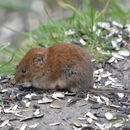Biology
provided by Arkive
Bank voles are active during both the day and night, although they become increasingly nocturnal during the summer (4). They do not hibernate in winter, but are active throughout the year (4). They have a broad diet, which is mainly herbivorous, including fruit, soft seeds, leaves, fungi, roots, grass, buds and moss. They may also occasionally take invertebrate food such as snails, worms and insects (4), and the odd bird egg may be eaten (2). Breeding typically takes place between April and October, but when conditions are suitable, births may occur throughout the year (4). Ovulation by the female is stimulated by the presence of a male, possibly via certain scents that males produce (5). Gestation takes around 21 days, but may be a short as 17 days in this species if conditions are optimal (5). Between 4 and 5 litters are produced in a year, each one consisting of 3-5 young (4). Females are able to conceive again whilst still suckling the previous litter; under these circumstances the gestation period will be longer, up to 24 days (5). The young voles are born in a nest, which is usually located underground (5). Males do not assist with rearing the offspring. Females are very protective of the litter; if any young leave the nest the female locates them and carries them back to the nest (5). The young become sexually mature at around 4.5 weeks of age, however those born later in the year will not start to breed until the next spring (4). Predators such as owls, kestrels, foxes and weasels take their toll on vole populations; the maximum life span for this species is 18 months. The numbers of bank voles varies greatly throughout the year, being high towards the end of summer and plummeting through the winter to a low in April (4).
Conservation
provided by Arkive
There is no conservation action targeted at this species.
Description
provided by Arkive
The bank vole has a small, stocky body and a blunt, rounded muzzle (2). The upperparts may be yellowish, reddish or brown in colour, the flanks are greyish and the rump is whitish-grey (2). The short tail is usually slightly bushy at the tip (2).
Habitat
provided by Arkive
This adaptable species (2) inhabits broadleaved woodlands, scrub, parks, hedgerows and banks where there is plenty of herbaceous cover (4).
Range
provided by Arkive
Common in Britain, including a number of the islands. On Skomer Island off the Pembrokeshire coast of Wales, there is a subspecies known as the Skomer vole (Clethrionomys glareolus skomerensis). The bank vole is also common throughout much of western and central Europe (4).
Status
provided by Arkive
Not legally protected in the UK. No conservation designations (3).
Threats
provided by Arkive
Where they occur in close proximity to roads, bank voles may be at risk from lead exposure. In agricultural areas, pesticide drift, and exposure to molluscicides and rodenticides may all pose threats. The fragmentation of woodlands, removal of hedgerows and overgrazing of herbaceous ground cover by deer reduce the chances of bank voles persisting in an area (4).

